什么是 Analysis?
Analysis 是通过分词器(Analyzer) 来实现的,可使用 ES 内置的分析器或者按需定制化分析器
举一个分词简单的例子:比如你输入 Mastering Elasticsearch,会自动帮你分成两个单词,一个是 mastering,另一个是 elasticsearch,可以看出单词也被转化成了小写的。
分词器的组成
分词器是专门处理分词的组件,分词器由以下三部分组成:
- Character Filters:针对原始文本处理,比如去除 html 标签
- Tokenizer:按照规则切分为单词,比如按照空格切分
- Token Filters:将切分的单词进行加工,比如大写转小写,删除 stopwords,增加同义语
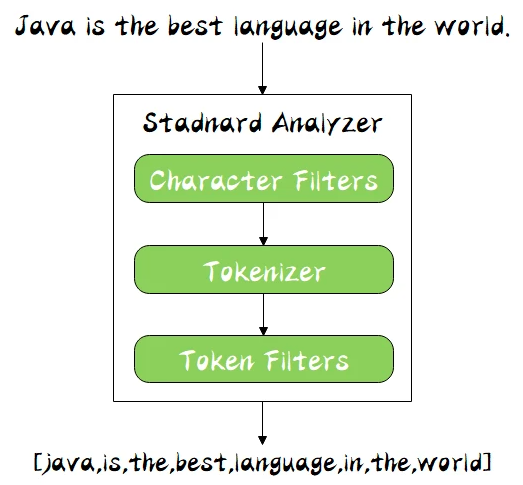
同时 Analyzer 三个部分也是有顺序的,从图中可以看出,从上到下依次经过 Character Filters,Tokenizer 以及 Token Filters,这个顺序比较好理解,一个文本进来肯定要先对文本数据进行处理,再去分词,最后对分词的结果进行过滤。
其中,ES 内置了许多分词器:
- Standard Analyzer - 默认分词器,按词切分,小写处理
- Simple Analyzer - 按照非字母切分(符号被过滤),小写处理
- Stop Analyzer - 小写处理,停用词过滤(the ,a,is)
- Whitespace Analyzer - 按照空格切分,不转小写
- Keyword Analyzer - 不分词,直接将输入当做输出
- Pattern Analyzer - 正则表达式,默认 W+
- Language - 提供了 30 多种常见语言的分词器
- Customer Analyzer - 自定义分词器
接下来会对以上分词器进行讲解,在讲解之前先来看下很有用的 API:_analyzer API:
Analyzer API
它可以通过以下三种方式来查看分词器是怎么样工作的:
直接指定 Analyzer 进行测试
GET _analyze{"analyzer": "standard","text" : "Mastering Elasticsearch , elasticsearch in Action"}
指定索引的字段进行测试
POST books/_analyze{"field": "title","text": "Mastering Elasticesearch"}
自定义分词进行测试
POST /_analyze{"tokenizer": "standard","filter": ["lowercase"],"text": "Mastering Elasticesearch"}
ES 分词器
Stamdard Analyzer
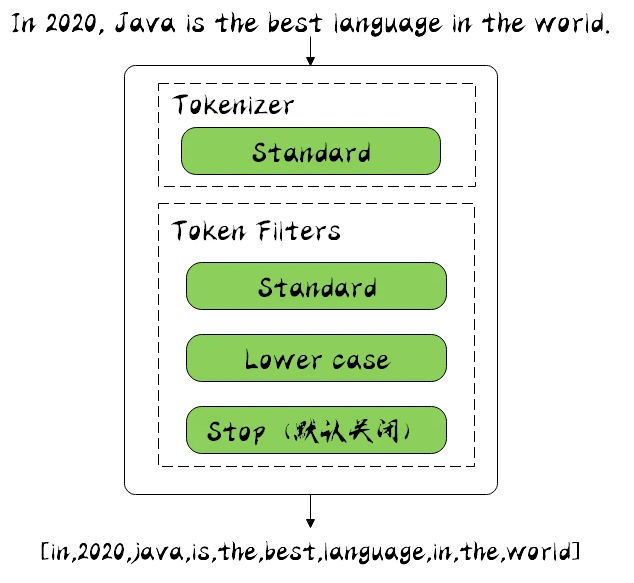
它是 ES 默认的分词器,它会对输入的文本按词的方式进行切分,切分好以后会进行转小写处理,默认的 stopwords 是关闭的。
下面使用 Kibana 看一下它是怎么样进行工作的,在 Kibana 的开发工具(Dev Tools)中指定 Analyzer 为 standard,并输入文本 In 2020, Java is the best language in the world.,然后我们运行一下:GET _analyze{"analyzer": "standard","text": "In 2020, Java is the best language in the world."}
运行结果如下:
{"tokens" : [{"token" : "in","start_offset" : 0,"end_offset" : 2,"type" : "<ALPHANUM>","position" : 0},{"token" : "2020","start_offset" : 3,"end_offset" : 7,"type" : "<NUM>","position" : 1},{"token" : "java","start_offset" : 9,"end_offset" : 13,"type" : "<ALPHANUM>","position" : 2},{"token" : "is","start_offset" : 14,"end_offset" : 16,"type" : "<ALPHANUM>","position" : 3},{"token" : "the","start_offset" : 17,"end_offset" : 20,"type" : "<ALPHANUM>","position" : 4},{"token" : "best","start_offset" : 21,"end_offset" : 25,"type" : "<ALPHANUM>","position" : 5},{"token" : "language","start_offset" : 26,"end_offset" : 34,"type" : "<ALPHANUM>","position" : 6},{"token" : "in","start_offset" : 35,"end_offset" : 37,"type" : "<ALPHANUM>","position" : 7},{"token" : "the","start_offset" : 38,"end_offset" : 41,"type" : "<ALPHANUM>","position" : 8},{"token" : "world","start_offset" : 42,"end_offset" : 47,"type" : "<ALPHANUM>","position" : 9}]}
可以看出是按照空格、非字母的方式对输入的文本进行了转换,比如对 Java 做了转小写,对一些停用词也没有去掉,比如 in。
其中 token 为分词结果;start_offset 为起始偏移;end_offset 为结束偏移;position 为分词位置。
下面来看下 Simple Analyzer 分词器:Simple Analyzer
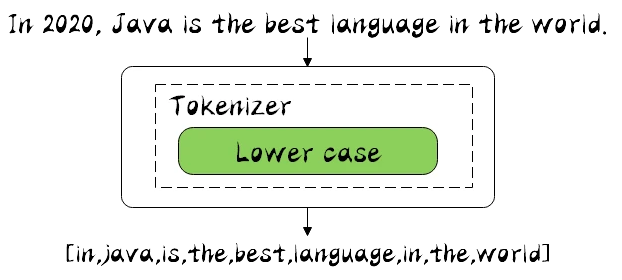
它只包括了 Lower Case 的 Tokenizer,它会按照非字母切分,非字母的会被去除,最后对切分好的做转小写处理,然后接着用刚才的输入文本,分词器换成 simple 来进行分词,运行结果如下:{"tokens" : [{"token" : "in","start_offset" : 0,"end_offset" : 2,"type" : "word","position" : 0},{"token" : "java","start_offset" : 9,"end_offset" : 13,"type" : "word","position" : 1},{"token" : "is","start_offset" : 14,"end_offset" : 16,"type" : "word","position" : 2},{"token" : "the","start_offset" : 17,"end_offset" : 20,"type" : "word","position" : 3},{"token" : "best","start_offset" : 21,"end_offset" : 25,"type" : "word","position" : 4},{"token" : "language","start_offset" : 26,"end_offset" : 34,"type" : "word","position" : 5},{"token" : "in","start_offset" : 35,"end_offset" : 37,"type" : "word","position" : 6},{"token" : "the","start_offset" : 38,"end_offset" : 41,"type" : "word","position" : 7},{"token" : "world","start_offset" : 42,"end_offset" : 47,"type" : "word","position" : 8}]}
从结果中可以看出,数字 2020 被去除掉了,说明非字母的的确会被去除,所有的词也都做了小写转换。
现在,我们来看下 Whitespace Analyzer 分词器:Whitespace Analyzer
它非常简单,根据名称也可以看出是按照空格进行切分的
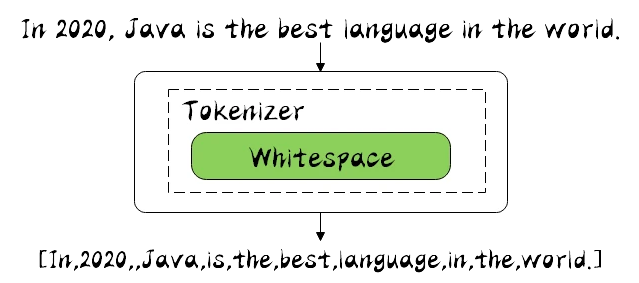
{"tokens" : [{"token" : "In","start_offset" : 0,"end_offset" : 2,"type" : "word","position" : 0},{"token" : "2020,","start_offset" : 3,"end_offset" : 8,"type" : "word","position" : 1},{"token" : "Java","start_offset" : 9,"end_offset" : 13,"type" : "word","position" : 2},{"token" : "is","start_offset" : 14,"end_offset" : 16,"type" : "word","position" : 3},{"token" : "the","start_offset" : 17,"end_offset" : 20,"type" : "word","position" : 4},{"token" : "best","start_offset" : 21,"end_offset" : 25,"type" : "word","position" : 5},{"token" : "language","start_offset" : 26,"end_offset" : 34,"type" : "word","position" : 6},{"token" : "in","start_offset" : 35,"end_offset" : 37,"type" : "word","position" : 7},{"token" : "the","start_offset" : 38,"end_offset" : 41,"type" : "word","position" : 8},{"token" : "world.","start_offset" : 42,"end_offset" : 48,"type" : "word","position" : 9}]}
Stop Analyzer
它由 Lowe Case 的 Tokenizer 和 Stop 的 Token Filters 组成的,相较于刚才提到的 Simple Analyzer,多了 stop 过滤,stop 就是会把 the,a,is 等修饰词去除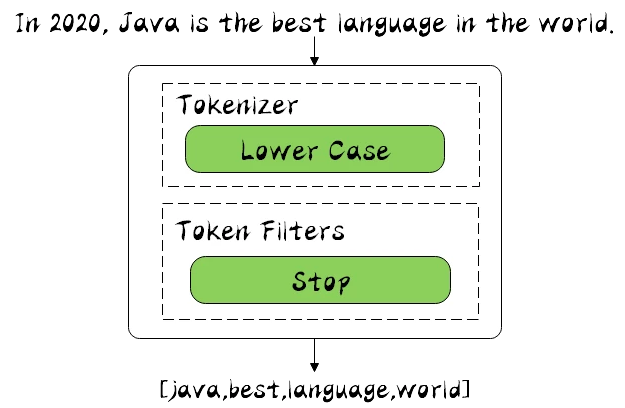
{"tokens" : [{"token" : "java","start_offset" : 9,"end_offset" : 13,"type" : "word","position" : 1},{"token" : "best","start_offset" : 21,"end_offset" : 25,"type" : "word","position" : 4},{"token" : "language","start_offset" : 26,"end_offset" : 34,"type" : "word","position" : 5},{"token" : "world","start_offset" : 42,"end_offset" : 47,"type" : "word","position" : 8}]}
Keyword Analyzer
它其实不做分词处理,只是将输入作为 Term 输出
我们可以看到,没有对输入文本进行分词,而是直接作为 Term 输出了。
{
"tokens" : [
{
"token" : "In 2020, Java is the best language in the world.",
"start_offset" : 0,
"end_offset" : 48,
"type" : "word",
"position" : 0
}
]
}
Pattern Analyzer
它可以通过正则表达式的方式进行分词,默认是用 \W+ 进行分割的,也就是非字母的符合进行切分的,由于运行结果和 Stamdard Analyzer 一样,就不展示了。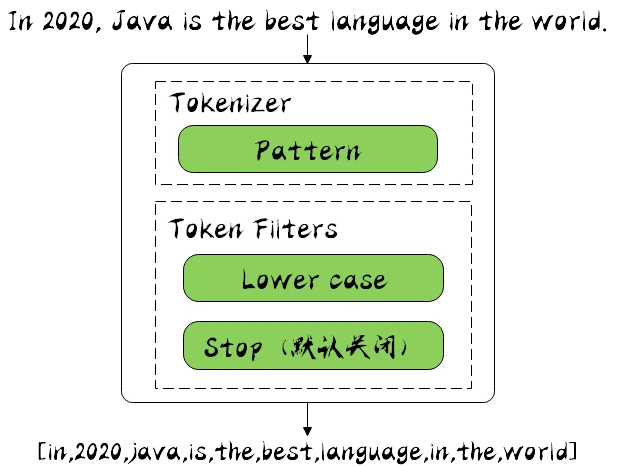
Language Analyzer
ES 为不同国家语言的输入提供了 Language Analyzer 分词器,在里面可以指定不同的语言,我们用 english 进行分词看下:
可以看出 language 被改成了 languag,同时它也是有 stop 过滤器的,比如 in,is 等词也被去除了。
{
"tokens" : [
{
"token" : "2020",
"start_offset" : 3,
"end_offset" : 7,
"type" : "<NUM>",
"position" : 1
},
{
"token" : "java",
"start_offset" : 9,
"end_offset" : 13,
"type" : "<ALPHANUM>",
"position" : 2
},
{
"token" : "best",
"start_offset" : 21,
"end_offset" : 25,
"type" : "<ALPHANUM>",
"position" : 5
},
{
"token" : "languag",
"start_offset" : 26,
"end_offset" : 34,
"type" : "<ALPHANUM>",
"position" : 6
},
{
"token" : "world",
"start_offset" : 42,
"end_offset" : 47,
"type" : "<ALPHANUM>",
"position" : 9
}
]
}

